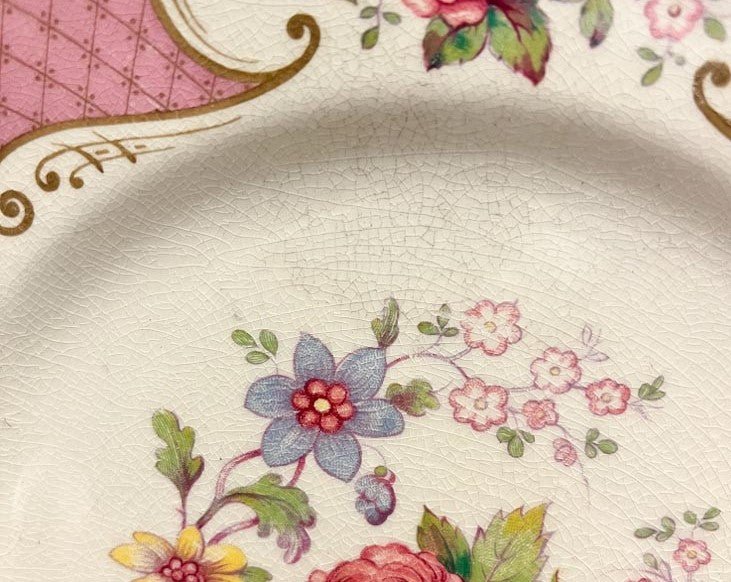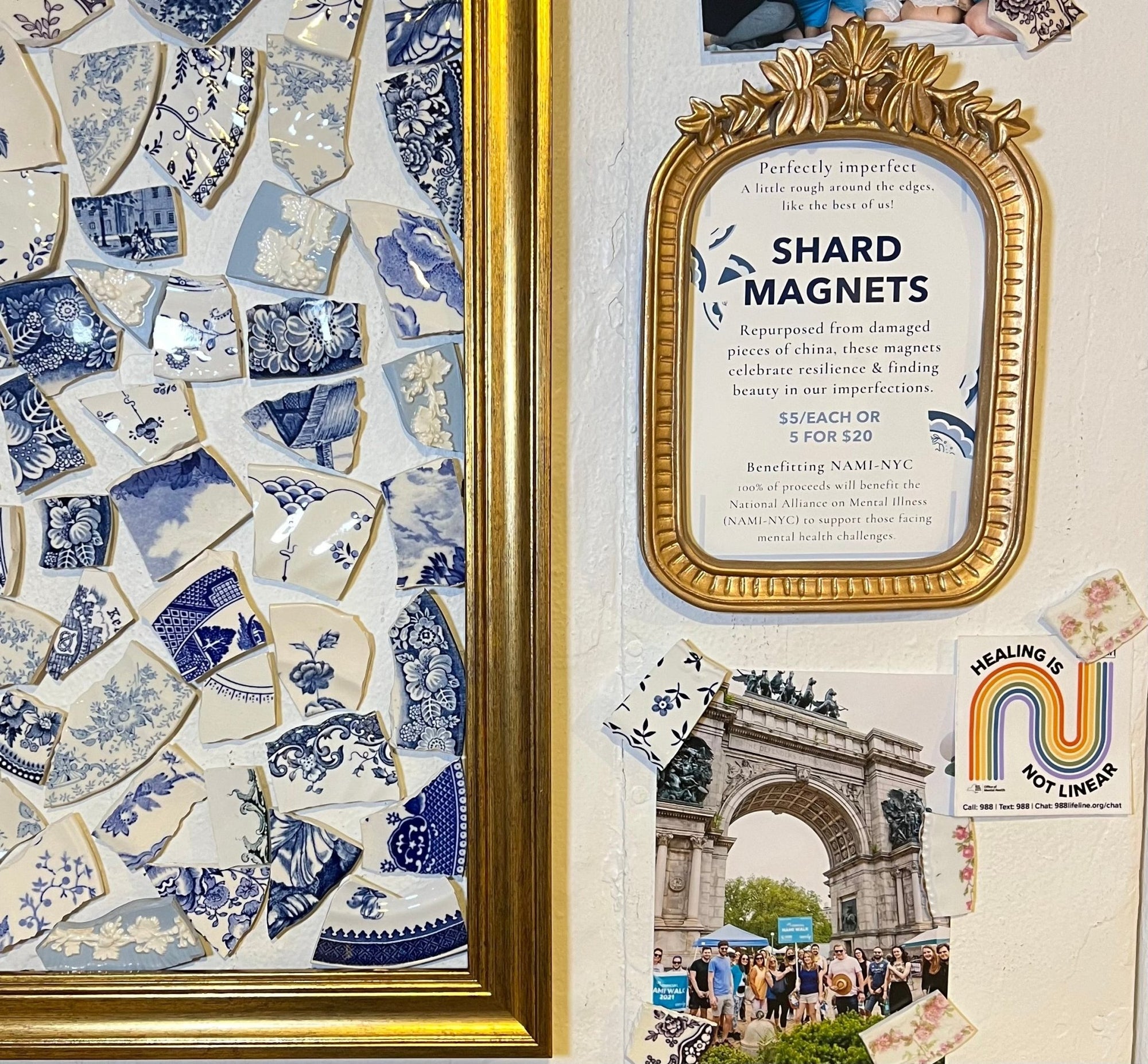Have you ever seen a piece of china that kind of looks like it’s covered with interconnected, hair-line thin cracks? Or maybe just a cluster or two of tiny crackles that resemble a spider's web?
Yep, that’s called crazing and it’s very common in pottery and fine china, especially in vintage and antique pieces.

Myott Staffordshire floral rose pattern with pink border seen from further away. Faint crazing visible only upon close examination.

Myott Staffordshire floral rose pattern with pink border on plate seen close up. Obvious and pervasive crazing visible across the entire surface of the plate with particles settled into cracks and crevices.
Some find these imperfections and signs of aging to be charming—a reflection of the object’s history that lends the piece extra charm and authenticity. However, not everyone likes the antiqued look caused by crazing. In particular, antique dealers find crazing to be frustrating, as it significantly diminishes the value of the china.
Is crazing in pottery and china a bad thing?
In short, spotting crazing in your china isn't great. Crazing in china is a sign of instability in the glaze, which can make it more fragile and susceptible to damage over time. Another problem caused by crazing is that it makes your pottery and pretty plates more difficult to clean. The tiny cracks makes it easy for food particles to get stuck, which turns the pieces into breeding grounds for bacteria.
What causes crazing in old plates?
Crazing can be caused by a variety of factors, but generally it’s due to age. As Tania of Little Vintage Cottage describes it, “much like humans with wrinkles developing as we age, pottery develops crazing “wrinkles” as it ages.
Other reasons for crazing:
- Moisture damage (i.e. exposure to moisture over time)
- Fluctuations in temperature and humidity (can happen when sets are stored in the garage in non-temperate climates)
- Being repeatedly jostled in storage
Crazing can happen with new pieces as well. Factors such as the composition and thickness of the glaze applied, the “firing temperature” in the kiln and the rate at which pieces are cooled also affect the rate of shrinkage of a piece and its relationship to the glaze. {source: The Teacup Attic}
Is it safe to eat off of pottery and china plates with crazing?
It is not advisable to eat directly off of plates with crazing. Food particles and bacteria can become trapped in the fine cracks which increases the risk of food contamination. If you want eat or serve off these lovely pieces regularly, we recommend using paper doilies, parchment paper, pastry tissue or foil liners to separate the food item from the potentially problematic plate.
Can you reverse or remove crazing in pottery and china plates?
Unfortunately you can't reverse crazing in plates. However, you can often remove the particles that settle into the cracks that cause stains and discoloration. One way to reduce the likelihood of crazing in the first place is through prevention. For example, don’t subject your china to the dishwasher. Instead, wash dishes by hand in warm water using a mild dish detergent.
Another way to reduce the chance of crazing is to keep the pieces in a consistent temperature (i.e. don’t store your fine china to the garage in climates that fluctuate dramatically throughout the year). For a complete guide to caring for your fine vintage china and transferware, check out the blog post.
Does The Brooklyn Teacup sell china or pottery with crazing?
You may encounter very subtle crazing in select pieces from our inventory. All of our dishware is vintage and has lived a previous life (or two!) We do our very best to ensure that our vintage plates, bowls, teacups, or anything that might be used for dining on a daily basis does not have this imperfection. We do not however sell anything that compromises the beauty of the piece. For example, we do not sell any items that appear stained, chipped or have discolored crazing (like the example you see below).

Stains are like this are typically the result of oils, tea/coffee, or other solutions settling into the cracks over time. All of our products are vintage or “pre-loved,” as we like to call it. It’s what gives them their unique beauty and charm—It’s also what sometimes makes them craze.
Do you have crazed china or old family heirlooms that you don’t know what to do with? Let’s talk.
At The Brooklyn Teacup, we love finding new uses for beautiful old dinnerware. We understand that it might make you nervous to eat off of these pieces of dinnerware. Instead, consider turning them into elegant and functional decor that you can use around the home, like a trinket tray or even a scented candle.
Browse The Brooklyn Teacup for inspiration and book a consultation to discuss or use our easy self-checkout to design your custom order manually. You'll receive instructions for shipping your china following check out.


Conclusions:
- Avoid eating directly off of plates with crazing
- Crazed plates are fine for occasional use, preferably with a barrier between the food item and the dish.
- Crazed pieces are great for upcycling into decor with non food-related uses, like a jewelry organizer or accessory tray.
If you still love your old dinnerware but don’t know what to do with it, consider upcycling your vintage china into any number of practical decor items for your home or creating meaningful keepsakes to share with loved ones.




Comment
What causes white residue on ceramic dishes from 1950s? I tried to get stains off of cups and plates using baking soda and water. After washing and drying them they produced white fluffy residue after sitting out to dry for 15 minutes?